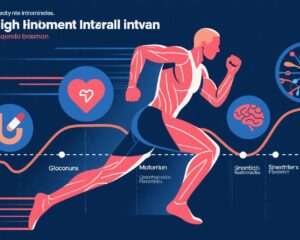Introduction
High-intensity interval training (HIIT) has gained significant popularity as an effective exercise regime that not only helps with weight management but also offers profound health benefits impacting cardiovascular, neurological, and metabolic systems. This article explores how HIIT can serve as a protective measure for these critical areas of health, backed by scientific research.
Understanding High-Intensity Interval Training
HIIT involves short bursts of intense exercise followed by varied recovery times. This approach differs from traditional steady-state cardio by allowing for increased cardiovascular fitness and improved metabolic functioning in less time. HIIT can consist of various activities, including sprinting, cycling, or bodyweight exercises, tailored to individual fitness levels.
Cardiovascular Benefits of HIIT
Multiple studies have demonstrated that HIIT can lead to significant improvements in cardiovascular health. These benefits include:
– **Improved Cardiovascular Endurance**: HIIT has been shown to enhance oxygen uptake, leading to better cardiovascular endurance. A study demonstrated that participants who engaged in HIIT improved their VO2 max (a key indicator of cardiovascular fitness) more sharply than those who performed moderate-intensity continuous training.
– **Lower Blood Pressure**: HIIT can contribute to lower resting blood pressure, which reduces the risk of heart disease. Research indicates HIIT lowers systolic and diastolic blood pressure after a few weeks of training.
– **Improved Lipid Profile**: Regular HIIT can lead to favorable changes in blood lipid levels, including decreased total cholesterol and triglycerides, which are vital for heart health.
– **Decreased Risk of Heart Disease**: By improving heart function and reducing risk factors such as blood pressure and cholesterol levels, HIIT may decrease the overall risk of developing cardiovascular diseases.
Neurological Advantages of HIIT
In addition to cardiovascular benefits, HIIT also presents significant advantages for brain health:
– **Cognitive Function**: Engaging in high-intensity workouts has been shown to improve cognitive functions, enhancing memory retention and learning capabilities. The increased blood flow from vigorous activities supports brain health.
– **Mood Enhancement**: Regular HIIT sessions can contribute to improved mood and decreased symptoms of anxiety and depression. Exercise, especially when performed at high intensity, promotes the release of endorphins, often referred to as “happiness hormones.”
– **Neuroprotective Effects**: HIIT may help in the prevention of neurodegenerative diseases by enhancing neurotrophic factors, which support neuron survival and growth. Research indicates that individuals who engage in regular physical activity have a lower risk of developing conditions such as Alzheimer’s disease.
Metabolic Health Benefits
HIIT has transformative effects on metabolic health, which are essential for managing and preventing conditions like obesity and type 2 diabetes:
– **Insulin Sensitivity**: Studies show that HIIT can significantly improve insulin sensitivity, aiding the body’s ability to use glucose effectively. This effect is particularly important for preventing metabolic syndrome and type 2 diabetes.
– **Fat Loss**: HIIT is efficient in promoting fat loss while preserving muscle mass. The afterburn effect, also known as excess post-exercise oxygen consumption (EPOC), allows the body to continue burning calories at an elevated rate post-exercise.
– **Enhanced Metabolic Rate**: By increasing metabolic rate, HIIT contributes to better overall energy expenditure, assisting in weight management and obesity prevention.
Conclusion
In conclusion, high-intensity interval training is not just a time-efficient workout—it is a powerful approach to enhancing cardiovascular, neurological, and metabolic health. Its unique structure delivers critical benefits that traditional exercise may not provide in the same way. Whether you aim to improve heart health, cognitive function, or metabolic efficiency, incorporating HIIT into your fitness routine could be a game-changer. As always, consult with a healthcare professional before starting any new exercise program, especially if you have any existing health issues or concerns.



